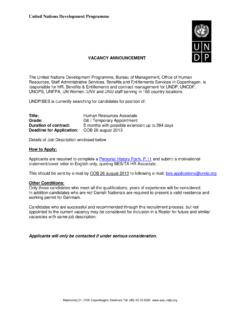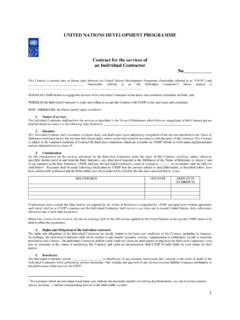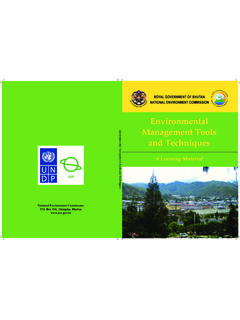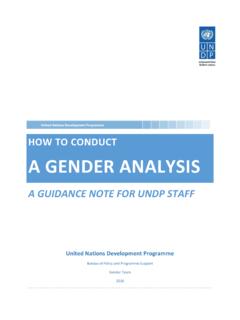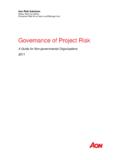Transcription of GOOD GOVERNANCE IN HEALTH
1 good GOVERNANCE IN HEALTH1 good GOVERNANCE IN HEALTH Skopje, October 2010 2 good GOVERNANCE in HEALTH Case studies: Municipalities of Kisela Voda, Kriva Palanka, Vrapchishte, Bitola, Strumica, Shtip, Kicevo and Veles Skopje, October 2010 The SEEU expresses appreciation to the United Nations Development Programme (UNDP) and Oslo GOVERNANCE Center for the technical and financial support during the production of this report. 3 Authors: Neda Milevska-Kostova, MSc, MPPM, Executive Director, CRPRC Studiorum Ardit Memeti, MA, Assistant professor, SEEU Aleksandar Stamboliev, MA, SCG, Researcher, CRPRC Studiorum Readers Group (in alphabetic order): Aferdita Haxhijaha-Imeri UNDP, Social Inclusion Practice Coordinator Igor Veljkovik UNICEF, HEALTH Officer Jadranka Sullivan UNDP, Social Inclusion Specialist Stefan Stojanovik UNAIDS Veli Kreci - SEEU Report Production Coordination: Shqipe Gerguri - SEEU Layout and Print: Arberia Design 4 Table of contents good GOVERNANCE IN HEALTH .
2 1 good GOVERNANCE IN HEALTH .. 2 CASE STUDIES: MUNICIPALITIES OF KISELA VODA, KRIVA PALANKA, VRAPCHISHTE, BITOLA, STRUMICA, SHTIP, KICEVO AND VELES .. 2 I. INTRODUCTION .. 7 THE RESEARCH PROBLEM, RESEARCH OBJECTIVES, RESEARCH QUESTIONS .. 9 RESEARCH METHOD, RESEARCH METHOD LIMITATIONS .. 10 RESEARCH SAMPLE .. 11 II. THE MACEDONIAN HEALTH SYSTEM AND THE SOCIAL INCLUSION .. 12 HEALTH SYSTEM IN MACEDONIA .. 12 ACCESS TO HEALTHCARE SERVICES .. 15 SOCIAL INCLUSION AND HEALTHCARE .. 16 III. good GOVERNANCE IN MACEDONIAN HEALTHCARE SYSTEM .. 19 1. LEGITIMACY AND VOICE .. 19 Citizen participation in HEALTH policy making .. 20 Citizens monitoring of HEALTH services .. 20 Participatory budgeting .. 21 2. LEADERSHIP .. 23 3. PERFORMANCE .. 24 4. ACCOUNTABILITY.
3 25 Horizontal accountability .. 26 State Audit Office .. 26 Management and inspectorates .. 26 Vertical accountability .. 27 5. TRANSPARENCY .. 27 6. FAIRNESS .. 28 How HEALTH GOVERNANCE affects social inclusion in Macedonia .. 29 Respect of the culture of non-majority communities .. 29 Providing HEALTH services and support for persons with special needs .. 29 Healthcare services for vulnerable groups .. 30 Implementation of the social inclusion policies .. 30 IV. CONCLUSIONS AND RECOMMENDATIONS .. 32 1. FIRST LINE RECOMMENDATIONS .. 32 Recommendations to the state actors .. 33 Recommendations to the CSOs and 33 2. SECOND LINE RECOMMENDATIONS .. 34 Recommendations to the state and local government actors: .. 34 Recommendations to the CSOs and 35 BIBLIOGRAPHY.
4 36 5 Background Information Over the past 15 years, GOVERNANCE has become a key concept in the debates related to international development. GOVERNANCE assessments vary according to the interests, needs and culture of the researchers. Some focus mostly on public sector corruption; others take a broader approach which can include elements of human rights and democracy examined across civil society, the private sector, the judiciary and government institutions. Experience shows that emphasis to GOVERNANCE is crucial for HEALTH /education systems to fulfill their essential public HEALTH / public education functions. Both HEALTH and education GOVERNANCE encompass institutions and linkages among citizens, government officials and HEALTH /education service providers.
5 Ideally, good GOVERNANCE in HEALTH and education should have the traits of responsiveness and accountability, transparency, encompass engagement of citizens and the capacity of state actors (central and local government decision makers) to design and implement policies in these sectors. For that reason, in the past 18 months (March 2009 September 2010) SEE University teamed up with UNDP, has agreed to develop a nationally owned GOVERNANCE Assessment Methodology ( ). This methodology should provide the tools for assessing the GOVERNANCE in HEALTH and education sector with regard to social inclusion and poverty reduction. However, with minor adaptations, this methodology can be used as a foundation for GOVERNANCE assessment mapping in other sectors, and provide much needed overview of GOVERNANCE issues and their impact on social inclusion.
6 This methodology is developed to serve as a critical accountability mechanism for variety of stakeholders, especially the citizens of the Republic of Macedonia and non-state actors regarding GOVERNANCE as well as to the decision makers to have the necessary information to improve the GOVERNANCE system and as such substantively contribute to the GOVERNANCE reform processes initiated in the country. Upon completion of the draft methodology, two research institutions were engaged to conduct GOVERNANCE assessment based on the Methodology on GOVERNANCE Assessment on social 6 inclusion policies in education and HEALTH sector. The findings from the research were also used as a tool for fine tuning the methodology itself. Once the methodology was agreed, the University embarked to pilot it in two selected sectors, in education and in HEALTH .
7 Two research institutions were selected to organize and conduct the field research and analyze the gathered data. The education report is produced by the Center for Research and Policy Making (CRPM) and features GOVERNANCE assessment of the education sector in 6 municipalities. Whereas, the HEALTH report is produced by the Centre for Regional Policy Research and Cooperation Studiorum (CRPRC Studiorum) and features GOVERNANCE assessment of the HEALTH sector in 6 municipalities. Both reports were presented at a workshop hel November 17, 2010, and the comments and recommendations from the participants have been taken into consideration in the process of fine tuning of the GA Methodology. In late January 2011, 40 stakeholders from different ministries, public institutions and Civil Society Organizations will be trained on the final GA Methodology.
8 The Final Assessment Methodology on GOVERNANCE issues and their impact on social inclusion in the education and HEALTH sectors in the Republic of Macedonia is scheduled to be launched in March, 2011. 7 I. Introduction good GOVERNANCE in HEALTH generally refers to the enhancement of the leadership and stewardship functions and the improvement of management support systems of both the central and local governments in terms of their collective responsibility for the overall performance of the HEALTH system. It also entails setting up the policies and the systems for transparency and accountability, mustering the political will to enforce the rules, and providing the right incentives to ensure positive behaviors of players in the HEALTH system.
9 Beyond the vision and mission to develop policies, programs and strategies that support the overall HEALTH goals and objectives, good GOVERNANCE also necessitates a clear system of data gathering about the implementation of these policies on every level in terms of accountability and transparency, but moreover about the effects of these policies on the HEALTH status of the general population, and particularly on specific groups of interest, such as the vulnerable and most-at-risk population groups. A good HEALTH knowledge and data management system needs to be selective in the information it generates to avoid inefficiencies and wastage of limited resources. It is critical that knowledge is disseminated to provide support for policy and decision-making, to build constituency of public support for HEALTH policy, to form part of capacity-building program, and to inform and influence behavior and events within the HEALTH This report is based on the pilot application of the good GOVERNANCE assessment methodology in the HEALTH sector, especially in the perspective of the social inclusion of the vulnerable population groups in the society.
10 Based on the assessment methodology and for the purpose of this report, social exclusion and social inclusion are understood as: (1) Social exclusion: a process whereby certain individuals are pushed to the edge of the society and prevented from participating fully because of their poverty, lack of basic competencies and life-long learning opportunities, or as a result of discrimination; they have little access to power and decision-making bodies and thus often feel powerless and unable to exercise any influence on the decisions that affect their daily lives; whereas (2) Social inclusion: mainstreaming of human rights in development programming is a way of tackling certain forms of social exclusion and strengthening inclusion policies.





